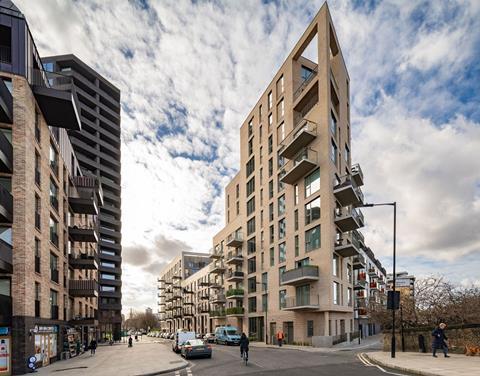Thanks to government subsidy, housing associations have typically carried on building through a downturn as the volume housebuilders slow down. But, as Carl Brown finds out, there is considerable scepticism about whether they can do so again this time around
ŌĆ£Demand from the social sector stood between the housebuilding sector and near-oblivion,ŌĆØ wrote Matthew Bailes, in Housing Today . He was reminiscing about his time as a senior civil servant in the department responsible for housing in the midst of the 2008 financial crisis and subsequent recession.
As anybody familiar with the housebuilding market at that time will tell you, the housing association sector stepped in and kept development going ŌĆō and the construction supply chain moving ŌĆō as the activity of the big private housebuilders slowed rapidly.
And this historically has often been the case. Housing associationsŌĆÖ business model, underpinned by high levels of government grant and a steady and secure rental income stream (again indirectly supported by the taxpayer through housing benefit to some residents) means that they are more insulated than others from economic storms. And, of course, demand for low-cost rental housing if anything only grows in difficult economic times.
So, 15 years ago, housing associations carried on building and also used their balance sheet to snap up homes that were built by volume housebuilders but could not be sold.

Official figures show that homes completed by private housebuilders peaked at 42,210 in the final quarter of 2007, before plummeting to 19,520 in the first quarter of 2010. Housing association development by contrast remained steady over the same period at around 6,800 homes a quarter.
When you factor in completions by final tenure in 2011, just under 50,000 homes ended up as housing association homes compared to around 70,000 for volume housebuilders. Before the crash these numbers were around 30,000 and 200,000 respectively.
What is clear is that the housing association sector, supported by the taxpayer, stepped up. But, as we stand on the brink of another recession, is the sector, which currently builds around one in four new-build homes, ready to step up again and play its ŌĆ£counter-cyclicalŌĆØ role in the market?
Many are not so confident this time around. ŌĆ£In my heart of hearts, IŌĆÖm not sure whether there is going to be the ability to do that [this time], the capacity to do that, the will to do that or the money or resources to do that,ŌĆØ said Geeta Nanda, chief executive of Metropolitan Thames Valley at an event in London last month.
So why are people worried? Before looking at the concerns in detail, it is worth reminding ourselves how housing associations fund development.
In simple terms, it is through a mixture of their own surpluses, government subsidy in the form of grant, borrowing and rental income. Arguably each of these is currently being eroded, or in danger of being eroded.
Rising inflation and the economic turmoil following SeptemberŌĆÖs disastrous ŌĆ£mini-BudgetŌĆØ mean borrowing costs have never been more in the spotlight. Due to cuts in grant rates per home, housing associations are going to go into the likely recession having to borrow much more money as a percentage of housing development costs compared with in previous recessions.
The total amount of grant per home was around ┬Ż53,000 in 2008, falling to ┬Ż22,000 in the austerity era of the David Cameron government, before rising again, but only to ┬Ż38,500 in Homes EnglandŌĆÖs 2021-26 affordable homes programme.
For EnglandŌĆÖs largest housing associations, which , the rise in debt costs is therefore problematic.
It is particularly difficult for those taking out new debt. According to the Regulator of Social Housing (RSH), associations are planning to agree ┬Ż47bn of new debt over the next five years, including refinancing, increasing the sectorŌĆÖs debt facilities to ┬Ż129bn by 2026/27.
While around 80% of debt in the sector is fixed, a ŌĆ£substantial number of providers have at least 25% of debt at variable rate and will face rapidly rising costsŌĆØ, RSH said last month.
The big word we are hearing is uncertainty. We donŌĆÖt know how long high inflation is going to last, we donŌĆÖt know how interest rates will change, we donŌĆÖt know whatŌĆÖs happening to rent-setting, or to demand for properties
Keith Ward, RSM
Piers Williamson, chief executive of the Housing Finance Corporation, said the cost of 30-year finance has increased from around 3% to 6%. And although 10-year gilt yields ŌĆō seen as a measure of the marketŌĆÖs concerns about the UK economy ŌĆō have come down slightly from the 4.40% seen after the mini-Budget, they are still historically high at around 3.40%, compared to less than 1% at the start of the year.
Williamson says the result is likely to be a pause in raising finance for development: ŌĆ£Real estate is getting hammered but itŌĆÖs too early to get any sort of forced sellers. So, we havenŌĆÖt had any price adjustments filter through yet.
ŌĆ£Therefore the natural thing to do, whether itŌĆÖs housing association or anyone else, is to sit on your hands, until you start to see some reaction in terms of the cost of your core components the cost of land or the cost of a developmentŌĆØ.

Williamson says where finance is raised it is likely to be more short-term debt on variable rates, as opposed to long-term bonds on fixed rates of interest in the current environment. ŌĆ£That may come back to bite them though in two or three yearsŌĆÖ time if there is a hardening of credit appetite of banks impacted by the bad debts that will start to pick up as the cycle gets worse.ŌĆØ
Keith Ward, national head of social housing at auditor RSM, says most development finance is in place for homes developed in the next two or three years. Therefore, any pause in financing would not hugely affect development until 2025/26 onwards.
ŌĆ£The big word we are hearing is uncertainty. We donŌĆÖt know how long high inflation is going to last, we donŌĆÖt know how interest rates will change, we donŌĆÖt know whatŌĆÖs happening to rent-setting, or to demand for properties,ŌĆØ says Ward.
ŌĆ£I think it might have an impact in terms of people putting plans on hold.ŌĆØ
It would be a mistake to think the impact of increased borrowing only affects new debt. As Paul Hackett, chief executive of Optivo, points out, when housing associations appraise a new development opportunity they set their ŌĆ£hurdle rateŌĆØ ŌĆō a minimum return they need to make a project viable ŌĆō in line with the gilt or cost of government borrowing.
This is because housing associations build schemes with long-term returns in mind and they need an accurate picture of the new borrowing from group facilities that is coming in all the time.
ŌĆ£Every housing association, however liquid, will want to make sure those schemes do reflect the higher cost of capital in order to be investing in the best value for money opportunities and that will mean housing associations scrutinising every single scheme they have in their pipeline and asking, what else can we do?,ŌĆØ explains Hackett.
ŌĆ£Is there anything that can be done on land price? Is there anything that can be done around mix? WhatŌĆÖs the likely impairment impact? If there is market sale and shared ownership exposure, what would that do to our income and expenditure?ŌĆØ
Hackett says the higher cost of borrowing, could send schemes ŌĆ£underwaterŌĆØ, while the risks of sales prices reducing in the short term could also trigger impairments on associationŌĆÖsŌĆÖ balance sheet.
All of this, he says, will lead to ŌĆ£extreme cautionŌĆØ, says Hackett, whose organisation Optivo has already put all . And this is before we mention the governmentŌĆÖs proposed rent increase cap, which is set to cost the housing association sector billions in lost rental income.
The current rent standard allows for social landlords to raise the cost of rents by the value of CPI in September, plus 1%, implying that tenants would be facing rent rises of up to 11.8% from next April.
However, the government is consulting on limiting this increase to 5% for one year due to the cost-of-living crisis. According to the governmentŌĆÖs impact assessment, this would And the G15 group of associations in London says this will cost its members alone
Nanda, chair of the G15, has warned of significant reductions in development, along with the slowing down of planned building safety works and improvements to existing stock. She says: ŌĆ£Fewer new affordable homes will be built, progress on decarbonisation and retrofitting will be curtailed and the financial capacity of organisations will be reduced if key ratings and measures are negatively affected.ŌĆØ
Ward says the impact of the rent cut will affect different housing providers differently depending on how exposed they are to inflationary costs. For instance, organisations needing to invest in catching up on pandemic-delayed repairs and maintenance will need to spend more on materials, which are surging in price.
Piers Williamson notes a regional difference in terms of the impact to the hit to finances from both the rent cap and increased borrowing costs. He says London associations are more likely to have fire safety remediation costs, higher market exposure and typically have larger rolling development programmes, while many have money going into retrofit also.
He says: ŌĆ£Non-London associations donŌĆÖt have fire remediation costs, the cost of land acquisitions is less, and you can carry out more incremental activity in a more de-risked wayŌĆØ.
However Tracy Harrison, chief executive of the Northern Housing Consortium, also says her organisationŌĆÖs members are impacted and are taking a ŌĆ£prudent approach to future development plansŌĆØ.

She adds: ŌĆ£A potential rise in the cost of finance is just one of the issues currently facing our members, alongside a potential rent ceiling, the rising cost of materials and labour and a cost-of-living crisis that is hitting residents hard.ŌĆØ
Housing associations are also seeking long-term certainty over rental income levels. While rental income will almost certainly be constrained, there are concerns in the current climate about the continuing ability of housing associations to cross-subsidise the funding of the affordable housing programme through the selling of homes on the open market or through shared ownership.
Several housing associations, including notably , and , have taken advantage of the strong housing market to boost their surplus and turnover through market sale. In 2020/21, housing associations generated around ┬Ż490m in surplus from market sales and first-tranche shared ownership sales combined.
However outright market sale activity, which is heavily concentrated in a relatively small number of providers, is obviously ŌĆ£pro-cyclicalŌĆØŌĆō ie, it expands during economic booms and contracts during recessions.
Ward says: ŌĆ£WhatŌĆÖs going to happen for demand for those new homes? If they are using those sales to subsidise their affordable housing development, that is a source of income that could be under threat.ŌĆØ
IN NUMBERS: Housing associationsŌĆÖ sales activity
Shared ownership first tranche sales receipts ┬Ż1.6bn
Shared ownership first tranche surplus generated ┬Ż270m
Outright market sales receipts generated ┬Ż1.9bn
Outright market sale surplus generated ┬Ż220m
Source: RSH global accounts of registered providers 2020/21
While market sales appetite demand may diminish, many in the sector are more hopeful about shared ownership. Ian Johnson, chief financial officer at Metropolitan Thames Valley Housing ŌĆō one of sectorŌĆÖs largest developers of shared ownership housing with more than 8,500 homes delivered through its SO Resi Brand ŌĆō seems confident there will still be demand for the product even in a recession.

He says: ŌĆ£Shared ownership has in past downturns proven to be more resilient, with its price point creating a degree of insulation from the risk of unaffordability.ŌĆØ
Ben Denton, managing director of for-profit provider Legal and General Affordable Homes, agrees and gives an example of an average three-bedroom property outside London worth ┬Ż300,000 bought with a three-year fixed mortgage.
He says mortgage rates have increased from 3.75% to 6.75% - an 80% rise - in the second quarter of the year, but the monthly cost of the mortgage on the typical L&G shared ownership property has increased by just 19%.
He says: ŌĆ£While it is an unwelcome increase, it also shows how shared ownership is a great product insulating purchasers from the full force of interest rate increases.ŌĆØ
Shared ownership has in past downturns proven to be more resilient, its price point creating a degree of insulation from the risk of unaffordability
Ian Johnson, Metropolitan Thames Valley Housing
Denton expects shared ownership demand to be strong as it ŌĆ£continues to be more affordable than the equivalent open-market rent homeŌĆØ.

MetropolitanŌĆÖs Johnson also sees a potential silver lining in the drop in land values that one might reasonably expect in a recession. He says: ŌĆ£Housing associations could be well placed were land values to fall, however normally there is a reasonably long lag before this filters into the market.ŌĆØ
While shared ownership demand may remain strong, or even increase, and there may eventually be more land opportunities, there are not many other reasons to be optimistic about housing association development in the looming downturn.
Housing associations are facing increased borrowing costs, they are paying more for materials and labour, they are faced with big bills for decarbonisation and (for some) building safety and are also under pressure to invest in improving existing stock.
A big question is what this all will mean for the ┬Ż11.5bn affordable homes programme. The five-year flagship initiative is intended to deliver 162,000 homes by 2026, including 35,000 in London
However, providers are now finding the grant they have been allocated does not go as far as they previously expected due to inflation.
The that inflation was a ŌĆ£major riskŌĆØ as increases in costs are ŌĆ£not reflected in initial bids and grant ratesŌĆØ. While Homes England and the Greater London Authority, which administers the scheme in London, can negotiate with providers about increasing their grant, there is only so much money in the pot to go round at the moment.
As Bailes wrote in his column: ŌĆ£There is little sign of flexibility on grant, including for the many providers with fixed grant rates locked into strategic partnerships with Homes England and the GLA [and] there are rumours funding could be cut in JeremyŌĆÖs HuntŌĆÖs budget.ŌĆØ
Hackett says, without offering extra grants, the government may have to accept fewer homes delivered for the same amount of public money. And yet this is really what the debate comes down to.
Housing associations have historically been able to carry on building because of high levels of public money subsidising their build. But, as grant rates per unit are lower historically than in previous recessions, and there is much more market exposure, a slowdown in their development activity is more likely this time around.
>> See also: Gove is back - the key questions for the returning housing secretary
>> See also: Are we seeing the start of a housing development slowdown?
James Prestwich, director of policy and external affairs at the Chartered Institute of Housing, says that when boards look at areas of discretionary spend they can cut, development is the obvious area.
He says some associations are still playing ŌĆ£catch-upŌĆØ on repairs and maintenance following the pandemic so that is not an area where there are likely to be savings.
He says: ŌĆ£Support services for tenants are more important than ever because of the impacts of the cost of living crisis. So you wonŌĆÖt be looking to make cuts there, and you certainly want to be prioritising your energy efficiency work with a 2030 target to get to EPC ŌĆ£CŌĆØ across your stock.
ŌĆ£ItŌĆÖs going to increasingly fall on development as the only way you can look to make savings.ŌĆØ
Most of the sectorŌĆÖs commentators point out that the government knows what it needs to do to ensure housing associations can build the economy out of trouble.
There is a well set out game plan for how you look to stimulate growth through a housing market downturn
James Prestwich, Chartered Institute of Housing
Prestwich says the government has a ŌĆ£playbookŌĆØ for building through a recession on its shelf ready to go. It is just a question of whether, as Rishi Sunak seeks ┬Ż50bn of savings, the government decides to use it.
ŌĆ£There are some big decisions for government to make,ŌĆØ Prestwich says.
ŌĆ£WeŌĆÖve been here before with a housing market downturn ŌĆō it is not an unusual occurrence. There is a well set-out game plan for how you look to stimulate growth through a housing market downturn, and that generally sees the more counter-cyclical social landlords stepping up with enhanced grant rates to be able to keep things moving.ŌĆØ
If the UK economy starts to grind to a halt and housebuilding with it, Sunak and Hunt may just find themselves dusting off that 2008 playbook to encourage associations to build.
A Fair Deal for Housing campaign

Ą■│▄Š▒▒¶╗ÕŠ▒▓į▓ĄŌĆÖs sister title Housing Today believes the government should not back away from its manifesto pledge of building 300,000 new homes a year by the middle of the decade. We badly need more homes and a lack of supply is a major factor in creating problems of affordability for both buyers and renters.
Over the next few months, Housing Today will be exploring potential solutions to help us ramp up housebuilding to 300,000. These are likely to, include different ways of working, funding asks of government and policy ideas that could boost housebuilding.
We want to hear from you: what do you think can make a difference at a policy level?
What can the industry do better?
We believe that, with the right commitments from ministers and the industry, it is possible to build more homes and help the government to meet its objectives to ŌĆ£build beautifulŌĆØ, improve quality and safety, boost home ownership and level up the UK.
To contribute ideas to our A Fair Deal for Housing Ideas Zone database,



























No comments yet